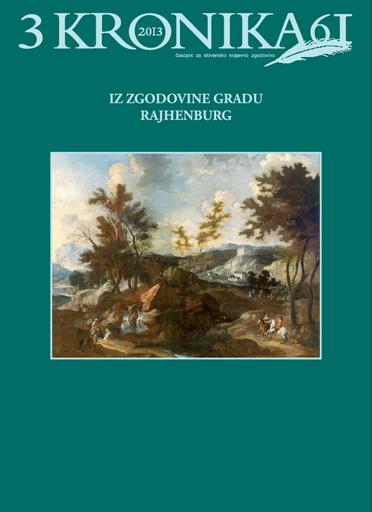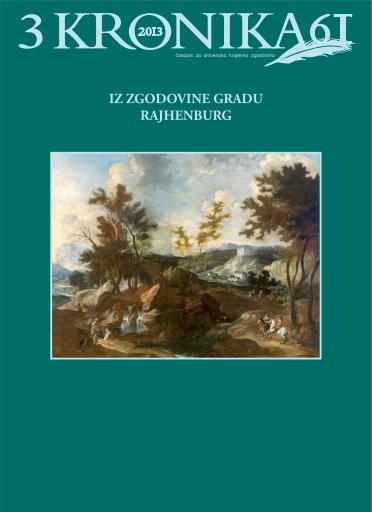/
Periodicals
/
Kronika: časopis za slovensko krajevno zgodovino
The Rajhenburg Castle as a Prison after the World WarII
Political Prison for Women (1948–1956) and the Male Offenders’ Correctional Facility (1956–1959)

Author(s):Andreja Jankovič Deržič
Co-author(s):Miha Preinfalk (odg. ur.), Barbara Šterbenc Svetina (teh. ur.), Alenka Cizel (prev.), Manca Gašperšič (prev.), Andreja Jankovič Deržič (prev.), Dejan Zadravec (prev.), Lidija Slana (prev.), Meta Osredkar (prev.), Agencija MultiLingual (prev.), Irena Bruckmüller Vilfan (prev.)
Year:2013
Publisher(s):Zveza zgodovinskih društev Slovenije, Ljubljana
Source(s):Kronika, 2013, št. 3
Language(s):slovenščina
Type(s) of material:text
Keywords:ženski politični zapor Rajhenburg (Brestanica), moški kazensko poboljševalni dom, življenje zapornic, The Rajhenburg (Brestanica) political prison for women, male offenders’ correctional facility, life of women as prisoners
Rights:

This work by Andreja Jankovič Deržič is licensed under Creative Commons Attribution-NonCommercial-NoDerivs 4.0 International
Files (1)

Name:kronika-2013_3.pdf
Size:66.73MB
Format:application/pdf
Permanent link:https://hdl.handle.net/11686/file18349
Description
The article discusses the material about the after-
war political prison for women on the Rajhenburg
Castle, which has not been researched until
now. It also deals with the male offender’s correctional
facility, which succeeded the female prison in
many respects. The central focus is on the lives of
the female prisoners and on the conditions they had to endure during their penalty. The article begins by
describing the process of the transportation of these
prisoners from the previous prison in Begunje and it
follows with the procedure, which had to be carried
out at the admission of the prisoners. The adaptation
of the castle, which was done before the alteration
of its purposes and was necessary for the
needs of the establishment, is also mentioned. It
also deals with the structures of the offences, which
the women were imprisoned for and emphasizes the
importance of education dictated by the current
political system. The importance of physical work,
which was supported by the government, is also
pointed out as the best means for altering the minds
of the political prisoners. It continues with the
description of the health system and the instructions
under which the wardens had to act in case of
a prisoner with a child or a pregnant woman. The
part of the article about the political prison for
women concludes with the reasons for termination,
instructions at the completion of the penalty and
the transportation of the convicts to another prison.
In the second, shorter part of this article, the
male offender’s correctional facility of an open type
is described. The central focus is the description of
an open-type of a prison, which was genuinely different
from the classical one. It portrays the rights
and duties of prisoners, as well as the privileges of
an open-type prison. At the end, it does not define
the reasons for closure of the prison because they
were not depicted in the archives. The article is
founded on the research of the material kept by the
Archive of the Republic of Slovenia and on the
professional scientific literature. It has to be noted
that the indicated material is very limited, because
several important data for the research have not
been registered or preserved. This theme is not well
treated in the foreign literature, which is why
Slovene historians have made an important step in
researching this period of history and have thus
lightened the young researchers’ quest for the appropriate
literature. The lack of the graphical
material should also be mentioned, which is common
to all totalitarian and authoritarian political
regimes. The prohibition of documenting, its sanctions
and the caution of the people is what led to
the shortage of the graphic material.
Metadata (12)
- identifierhttps://hdl.handle.net/11686/35001
- title
- Grad Rajhenburg kot zapor po 2. svetovni vojni
- Ženski politični zapor (1948–1956) in moški kazensko poboljševalni dom (1956–1959)
- The Rajhenburg Castle as a Prison after the World WarII
- Political Prison for Women (1948–1956) and the Male Offenders’ Correctional Facility (1956–1959)
- creator
- Andreja Jankovič Deržič
- contributor
- Miha Preinfalk (odg. ur.)
- Barbara Šterbenc Svetina (teh. ur.)
- Alenka Cizel (prev.)
- Manca Gašperšič (prev.)
- Andreja Jankovič Deržič (prev.)
- Dejan Zadravec (prev.)
- Lidija Slana (prev.)
- Meta Osredkar (prev.)
- Agencija MultiLingual (prev.)
- Irena Bruckmüller Vilfan (prev.)
- subject
- ženski politični zapor Rajhenburg (Brestanica)
- moški kazensko poboljševalni dom
- življenje zapornic
- The Rajhenburg (Brestanica) political prison for women
- male offenders’ correctional facility
- life of women as prisoners
- description
- Članek obravnava doslej še neraziskano gradivo o povojnem ženskem političnem zaporu na gradu Rajhenburg od leta 1948 do 1956. Dotakne se tudi moškega kazensko poboljševalnega doma, ki je deloval samo nekaj let, in sicer od leta 1956 do leta 1959. Osredotoča se predvsem na življenje zapornic in zapornikov, ki so na gradu prestajali zaporno kazen. Uvodoma je predstavljena premestitev zapornic iz predhodnega zapora, kakor tudi sama adaptacija gradu, ki je bila nujna za potrebe zapora. Dotakne se tudi izobraževanja, kulturno-prosvetnih dejavnosti in dela, ki so ga opravljale zapornice v času prestajanja kazni. V drugem, krajšem delu prispevka je opisan kazensko poboljševalni dom za moške odprtega tipa. Poudarek je predvsem na opisu delovanja odprtega tipa zapora, ki se je v veliki meri razlikoval od klasičnega.
- This article deals with a material on the Rajhenburg after-war political prison for women from 1948 till 1956, which has not been explored until now. It also touches upon the male offender’s correctional facility, which was active only for a few years, from 1956 until 1959. The article mainly focuses on the lives of the prisoners, women and men, who served their punishment on the castle. Firstly, the transportation of the female prisoners from the preceding prisons is described, and then it continues with the necessary adaptations of the castle for the demands of the prison. It also talks about education, cultural activities and work that the prisoners had to undertake during their punishment. In the second, shorter part of this article, the male offenders’ correctional facility of an open type is described. The central focus is the description of an open-type of a prison, which was genuinely different from the classical one.
- The article discusses the material about the after- war political prison for women on the Rajhenburg Castle, which has not been researched until now. It also deals with the male offender’s correctional facility, which succeeded the female prison in many respects. The central focus is on the lives of the female prisoners and on the conditions they had to endure during their penalty. The article begins by describing the process of the transportation of these prisoners from the previous prison in Begunje and it follows with the procedure, which had to be carried out at the admission of the prisoners. The adaptation of the castle, which was done before the alteration of its purposes and was necessary for the needs of the establishment, is also mentioned. It also deals with the structures of the offences, which the women were imprisoned for and emphasizes the importance of education dictated by the current political system. The importance of physical work, which was supported by the government, is also pointed out as the best means for altering the minds of the political prisoners. It continues with the description of the health system and the instructions under which the wardens had to act in case of a prisoner with a child or a pregnant woman. The part of the article about the political prison for women concludes with the reasons for termination, instructions at the completion of the penalty and the transportation of the convicts to another prison. In the second, shorter part of this article, the male offender’s correctional facility of an open type is described. The central focus is the description of an open-type of a prison, which was genuinely different from the classical one. It portrays the rights and duties of prisoners, as well as the privileges of an open-type prison. At the end, it does not define the reasons for closure of the prison because they were not depicted in the archives. The article is founded on the research of the material kept by the Archive of the Republic of Slovenia and on the professional scientific literature. It has to be noted that the indicated material is very limited, because several important data for the research have not been registered or preserved. This theme is not well treated in the foreign literature, which is why Slovene historians have made an important step in researching this period of history and have thus lightened the young researchers’ quest for the appropriate literature. The lack of the graphical material should also be mentioned, which is common to all totalitarian and authoritarian political regimes. The prohibition of documenting, its sanctions and the caution of the people is what led to the shortage of the graphic material.
- publisher
- Zveza zgodovinskih društev Slovenije
- date
- 2013
- type
- besedilo
- language
- Slovenščina
- isPartOf
- rights
- license: ccByNcNd
Citirano v (1)
| Tipologija | Avtor(ji) | Naslov | Kraj | Založba | Leto |
|---|---|---|---|---|---|
| 1.01 Izvirni znanstveni članek | Piškurić, Jelka | Začetki zapora na ižanskem gradu (1946-1956) | Ljubljana | Zveza zgodovinskih društev Slovenije | 2020 |
Seznam literature v delu (6)
| Stran | Avtor | Naslov | Vir | Kraj | Založba | Leto |
|---|---|---|---|---|---|---|
| 583 | Kovács Attila et, al. | Madžarska begunska problematika leta 1956 - Primer Jugoslavije in Slovenije | Razprave in gradivo, Revija za narodnostna vprašanja | 2009 | ||
| 583 | Mikola, Milko | Delo kot kazen | Celje | Zgodovinski arhiv Celje | 2002 | |
| 583 | Mikola, Milko | Rdeče nasilje | Celje-Ljubljana | Celjska Mohorjeva družba | 2013 | |
| 583 | Resnik, Mateja | Grad Brestanica od srednjeveške utrdbe do političnega zapora | Univerza v Mariboru: Pravna fakulteta | 1995 | ||
| 583 | Stanič, Ive A. | V čigavem imenu? | Kočevje | Kočevski tisk | 1996 | |
| 583 | Vode, Angela | Skriti spomin | Ljubljana | Nova revija | 2005 |
